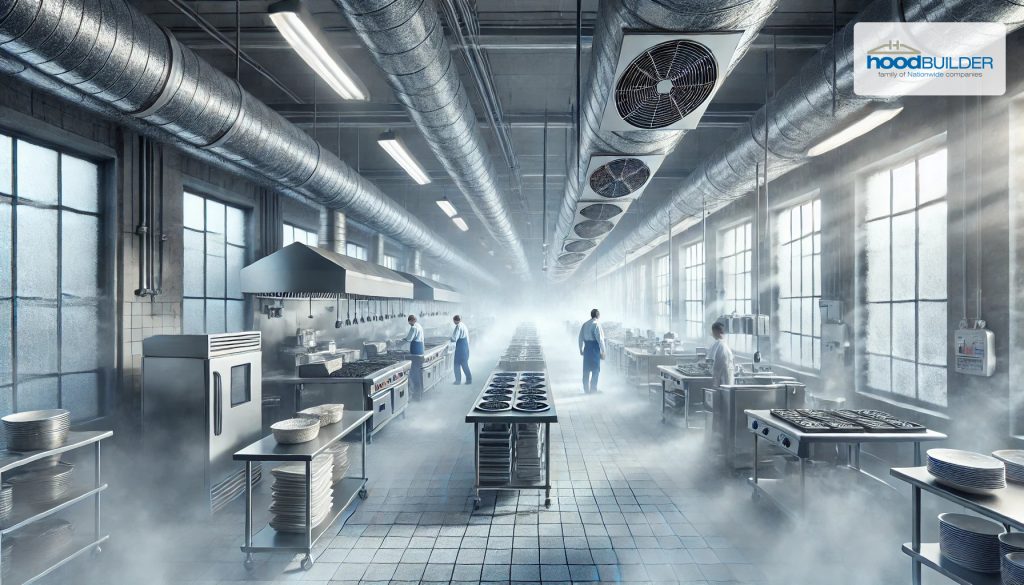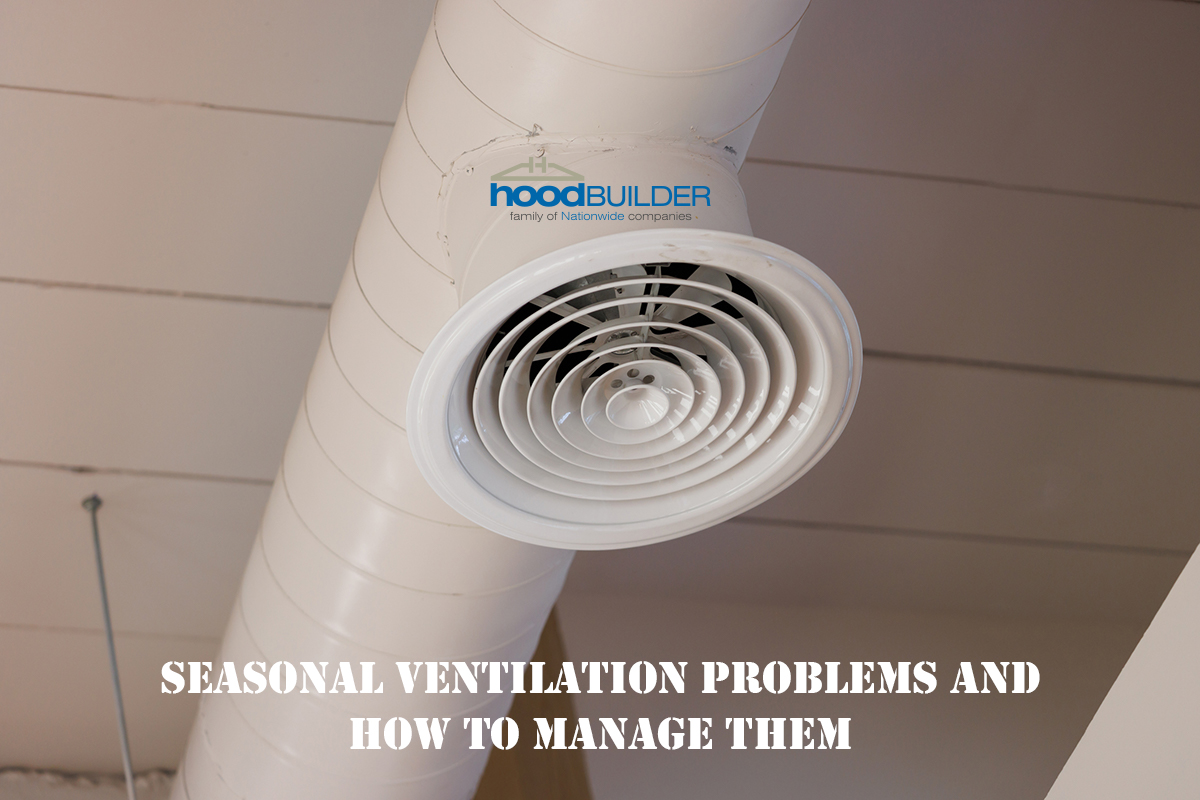In busy commercial kitchens, effective ventilation is crucial for keeping the air fresh, ensuring safety, and saving energy costs. So, as kitchens go from the heat of summer to the chill of winter, understanding these seasonal ventilation problems becomes much more important for chefs and managers alike.
Seasonal changes can pose serious challenges that impact ventilation systems, leading to issues such as temperature swings, humidity issues, and the accumulation of airborne contaminants.
This article dives into the common ventilation challenges faced in commercial kitchens throughout the year and provides some practical tips to ensure a safe, comfortable, and efficient cooking environment, no matter what the weather is like outside.
Give us a call at 800-750-7055 to discuss your ventilation issues with the expert team of Hood Builder.
The Importance of Proper Ventilation
Proper ventilation in a commercial kitchen is crucial for several reasons, impacting safety, efficiency, and overall kitchen performance. Here are the key points showing its importance:
1. Air Quality
Effective ventilation helps remove smoke, steam, grease, and odors, improving the air quality for kitchen staff and patrons. Also, Keeping the air flowing can help cut down on allergens and irritants, which is great for everyone’s health.
2. Temperature Control
Cooking equipment can heat things fast. Ventilation systems help dissipate this heat, ensuring a comfortable working environment. Moreover, by keeping optimal temperatures, ventilation reduces the need for additional cooling systems, saving energy costs.
3. Fire Safety
Good ventilation keeps grease and other flammable stuff from piling up, which lowers fire risks. Also in case of a fire, effective ventilation systems can help clear smoke quickly, helping in evacuation and fire response efforts.
4. Compliance with Regulations
Many health codes and regulations require enough ventilation in commercial kitchens to ensure safe working conditions. So, following these regulations is key to keeping your business running smoothly and avoiding any nasty fines.
5. Equipment Longevity
Proper ventilation helps to have optimal operating conditions for kitchen equipment, prolonging its lifespan by preventing overheating and excessive moisture.
6. Improved Cooking Performance
Good airflow ensures that cooking temperatures stay stable, leading to better food quality and consistency. Besides, getting rid of extra moisture and odors allows for better flavor retention in dishes.
7. Staff Comfort and Productivity
A well-ventilated kitchen reduces discomfort from heat and odors, leading to higher staff morale and productivity.
Moreover, improved air quality can reduce the risk of respiratory issues and other health problems for your kitchen crew
8. Pest Control
Proper ventilation helps manage humidity levels, making the environment less inviting for pests like insects and rodents.
In short, proper ventilation is not just a rule; it plays a vital role in ensuring a safe, efficient, and comfortable working environment in commercial kitchens. Investing in a good ventilation system can lead to improved air quality, enhanced safety, better equipment performance, and overall operational efficiency. Besides, regular maintenance of ventilation systems is also essential to ensure they function effectively.
Identifying Common Seasonal Ventilation Problems
– Summer Ventilation Challenges
High temperatures and humidity levels can cause discomfort for kitchen staff. This can affect food preparation and safety too. Moreover, summer is often a busy season, which means more cooking and increased heat in the kitchen. Balancing between effective ventilation and keeping a comfortable temperature can strain HVAC systems.
– Fall Ventilation Challenges
As temperatures begin to drop, kitchens may experience different heat levels. Also, with seasonal menu changes, more cooking may occur, requiring effective ventilation.
– Winter Ventilation Challenges
Open doors and windows can let in cold air, affecting kitchen temperatures. Besides, many kitchens reduce ventilation during colder months, which can lead to stale air and buildup of harmful gases. Cooking in cold conditions creates extra humidity, promoting mold growth.
– Spring ventilation Challenges
Increased pollen and allergens can affect air quality. As the weather warms up, kitchens may need to adjust their ventilation strategies.
– Other Common Seasonal Ventilation Problems
Rapid changes in outside temperatures can affect the efficiency of heating or cooling systems.
Also, seasonal events or holidays may lead to higher cooking volumes, and straining ventilation systems.
Changes in menu items with strong odors can overwhelm ventilation systems, especially during peak seasons.
The other challenge is equipment overload. Seasonal spikes in usage can cause wear and tear on ventilation equipment, leading to malfunctions.
Moreover, seasonal changes can affect airflow patterns, leading to areas of stagnant air or poor circulation.
The last but not the least is moisture management. Increased cooking methods that generate steam (like boiling) can lead to moisture issues, especially in humid months.
If you are searching for some professional help, look no further than Hood Builder.

Solutions and Tips for Addressing Seasonal Ventilation Problems
1. Humidity Control in the Summer
Use portable or built-in dehumidifiers to keep optimal humidity levels. Ensure exhaust hoods are efficient and have enough airflow to remove moisture quickly. Moreover, remember that regular maintenance is the key; so, clean and service ventilation systems to prevent blockages that can trap humidity.
2. Draft Prevention in the Winter
Use weather stripping on doors and windows to keep the cold out. Also, put up air curtains at entrances to create a barrier against cold drafts. Optimize heating settings to ensure comfort without overworking the system.
overdoing it.
3. Allergen Management in the Spring
Use HEPA filters to catch allergens and improve indoor air quality. Step up your cleaning routine to reduce dust and pollen accumulation.
4. Grease Control in the Fall
Schedule regular cleanings of exhaust hoods and filters to prevent grease buildup. Besides, use grease traps to capture excess grease before it enters the ventilation system and clogs it.
5. Temperature Regulation
Use smart thermostats that adjust based on the weather for better efficiency. Plus, ensure proper insulation of ducts and kitchen areas to maintain consistent temperatures.
6. Managing Increased Cooking Volume
Anticipate busy seasons and ensure ventilation systems are capable of handling increased loads.
Consider temporary additional fans or portable ventilation units during peak times.
7. Odor Control Strategies
Install activated carbon filters in exhaust systems to neutralize odors. Moreover, ensure all components of the ventilation system are well-maintained to prevent odor buildup.
8. Equipment Maintenance
Schedule regular inspections and maintenance for all ventilation equipment to ensure optimal performance. Besides, invest in newer, more efficient equipment if current systems are outdated or failing.
9. Airflow Optimization
Adjust dampers to ensure even airflow throughout the kitchen. Also, use air quality monitors to spot areas with stagnant air and adjust ventilation accordingly.
10. Moisture Management Techniques
Ensure exhaust fans are operational during cooking to remove steam and moisture promptly. Also, explore cooking methods that produce less moisture, such as grilling instead of boiling.
11. Additional Tips:
Educate staff on proper ventilation practices and the importance of keeping vents clear.
Have a plan in place for extreme weather conditions that may affect ventilation.
Engage HVAC professionals for assessments and recommendations tailored to specific kitchen needs.
Schedule routine inspections and maintenance of ventilation systems to ensure they are functioning optimally throughout the year.
Use monitoring systems that track temperature, humidity, and air quality to make real-time adjustments as needed.
All in all, understanding the seasonal challenges of kitchen ventilation is essential for maintaining a safe and efficient working environment. By proactively addressing these issues, commercial kitchens can ensure optimal performance year-round, enhance staff comfort, and maintain food safety standards.
Seasonal HVAC Maintenance Tips
Having enough information about efficient maintenance tips can be really valuable to help you keep your ventilation system running smoothly all year round.
In spring, replace or clean filters to improve airflow and efficiency. Check for leaks or blockages and seal any gaps. Also, debris, leaves, and dirt from the outdoor condenser unit should be removed. Ensure your thermostat is functioning correctly for the cooling season. Besides, have a technician inspect and service your system.
During the summer months, make sure furniture and other items aren’t blocking vents. Low refrigerant can affect cooling efficiency. Also, ensure ductwork is properly insulated to prevent energy loss. Remember to run your air conditioning to ensure it cools effectively before peak heat hits. Finally, use dehumidifiers if necessary to maintain comfort.
In the fall, replace filters to ensure optimal airflow. Check your furnace or heat pump for any possible issues. If you have a fireplace, clean and inspect the chimney. Check for drafts and use weather stripping to keep heat in. At last, get a professional to inspect your heating system before winter.
During winter months, ensure all vents are open and unblocked for even heating. Test and replace batteries in CO detectors as needed. If you use a humidifier, clean it regularly to prevent mold growth. Also, adjust settings for energy savings when you’re away and ensure your attic and walls are well-insulated to keep heat in.
Year-Round Tips:
Change or clean filters every 1-3 months depending on usage.
Ensure there’s plenty of space around indoor and outdoor units for airflow.
Keep an eye on your energy bills for any unexpected increases that might indicate an HVAC issue.
Lastly, understand how your HVAC system works to better identify potential problems.
Frequently Asked Questions on Seasonal Ventilation Problems
1. What Are Common Ventilation Issues in Commercial Kitchens During Different Seasons?
Summer: Increased heat and humidity can overwhelm ventilation systems, leading to discomfort and inefficiency.
Winter: Cold air drafts can affect kitchen temperatures, and improper heating can lead to condensation issues.
Spring/Fall: Allergens and outdoor air quality can impact indoor air quality, necessitating adjustments in ventilation.
2. What Maintenance Should Be Performed on Ventilation Systems Seasonally?
Regularly clean filters, inspect ducts for blockages, check exhaust fans, and ensure hoods are functioning properly. Seasonal checks should also include verifying that the system is adequately removing heat and moisture.
3. What Are the Benefits of A Balanced Ventilation System?
A balanced system ensures equal intake and exhaust of air, improving indoor air quality, maintaining comfort levels, and reducing energy costs by optimizing system performance.
4. When Should I Consult a Professional for Ventilation Issues?
If you notice persistent problems despite regular maintenance, significant changes in airflow or temperature, or unusual noises from the system, it’s advisable to consult an HVAC professional.
If you have any ventilation challenges, just team up with us at Hood Builder.
Ensure the Optimal Performance of Your Ventilation System in Denver, CO., and California
In conclusion, managing seasonal ventilation problems in commercial kitchens is crucial for having a safe and efficient working environment. By understanding the unique challenges posed by each season, you can use effective strategies to optimize your ventilation systems.
Regular maintenance, including cleaning filters and inspecting ductwork, is essential to ensure systems operate effectively year-round. Moreover, using advanced technologies, such as variable speed fans and dehumidifiers, can further enhance air quality and comfort.
Thus, by addressing these ventilation issues, your commercial kitchen can not only comply with health regulations but also create a more pleasant environment for all your staff and customers.
As experts, we tried to have an objective analysis of ventilation challenges and necessary maintenance practices and tips in different seasons during the year. Hood Builder assures you that with the help of our professionals, you will be able to find the choices that best suit your needs and solve your problems.

